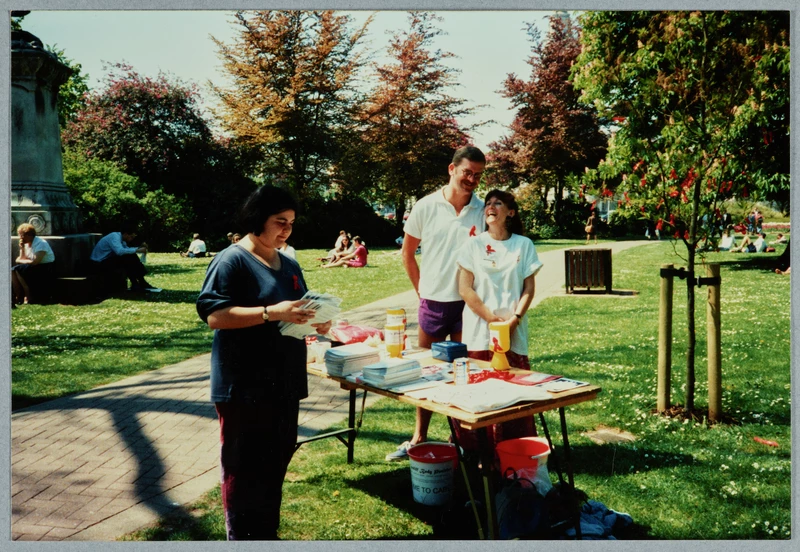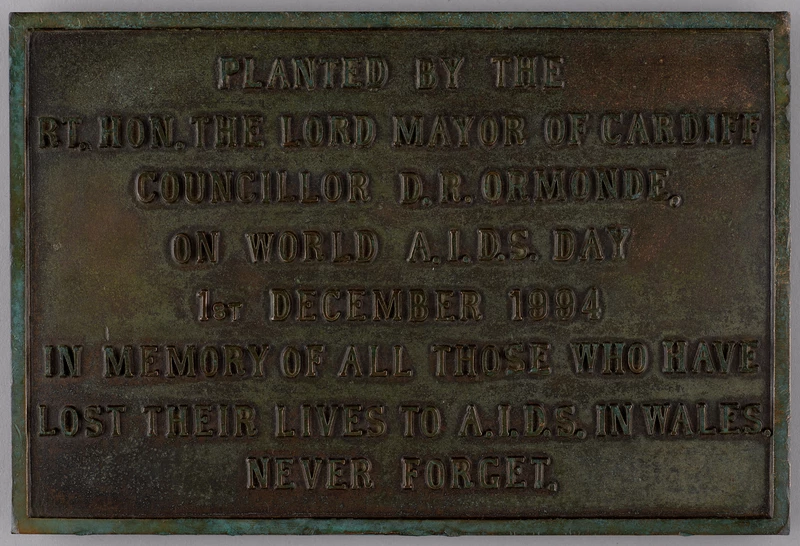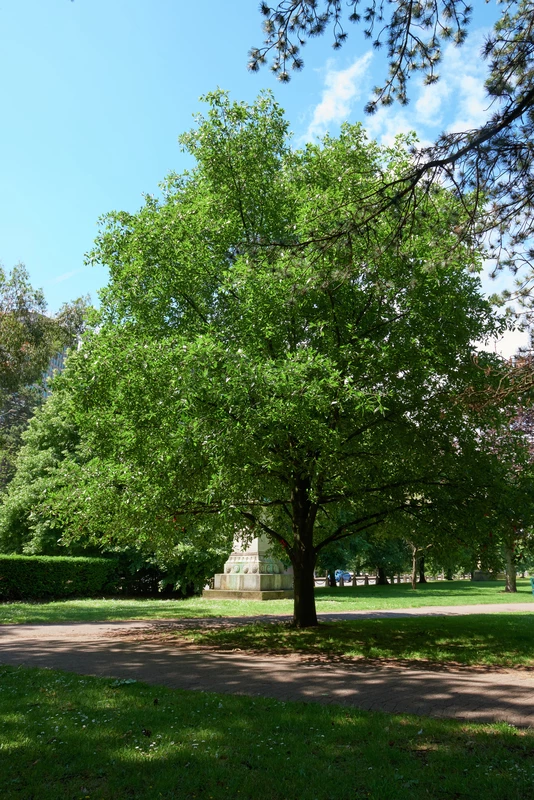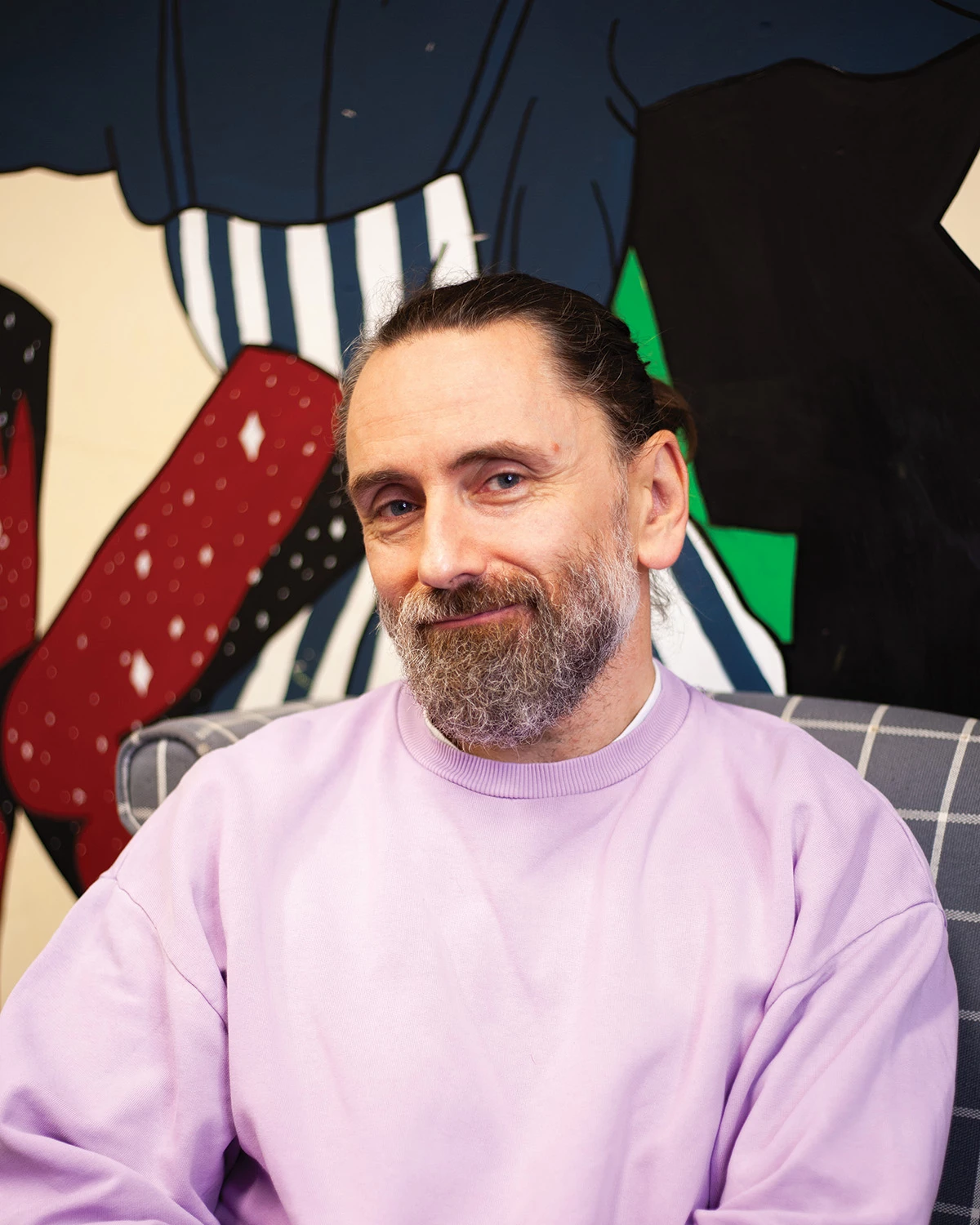Mark Etheridge ar Hanes ac Actifaeth LGBTQ+
, 27 Chwefror 2025
Mark Etheridge, Prif Guradur Datblygu Casgliadau: LHDTQ+
© Amgueddfa Cymru
Mae’n Fis Hanes LHDTQ+ a’r thema eleni yw Ymgyrchedd a Newid Cymdeithasol. Wedi’i sefydlu gan Schools Out yn 2025, mae Mis Hanes LHDTQ+ yn ofod penodol, neilltuedig i ddathlu hanes amrywiol a chyfoethog ein cymunedau LHDTQ+.
I nodi’r achlysur, buom yn cyfweld â’n prif guradur casgliadau LHDTQ+ yn Amgueddfa Cymru i archwilio’r eitemau yn ein casgliadau sy’n cofnodi’r adegau allweddol hyn yn hanes ymgyrchedd LHDTQ+ Cymru.
Helô Mark, a hoffech chi gyflwyno eich hun a dweud mwy wrthym am eich rôl yn Amgueddfa Cymru?
Hoffwn. Mark Etheridge ydw i. Fi yw Prif Guradur Datblygu Casgliadau: LHDTQ+ yn Amgueddfa Cymru, yn gweithio o Sain Ffagan Amgueddfa Werin Cymru.
Dechreuais y rôl hon wrth ddatblygu’r casgliad LHDTQ+ yn ôl yn 2019, ar adeg pan oedd nifer fach iawn o wrthrychau y gellid eu nodi fel rhai LHDTQ+. Roedd y gwrthrychau hyn yn ymwneud yn bennaf â ffigyrau hanesyddol, digwyddiadau Pride Cymru, ac Adran 28, ond nid oeddent ar unrhyw gyfrif yn cynrychioli croestoriad y gymuned LHDTQ+ gyfan ledled Cymru, yn y gorffennol ac mewn profiadau cyfoes ill dau.
Rwyf wedi gweithio gydag amrywiaeth o grwpiau cymunedol ac unigolion dros y blynyddoedd diwethaf i adeiladu casgliad sy’n llawer mwy cynrychioliadol ac mae gennym bellach gasgliad o dros 2,200 o eitemau wedi’u nodi fel rhai LHDTQ+.
Baner brotest a wnaed gan CYLCH mewn gwrthdystiad yn erbyn Adran 28.
© Amgueddfa Cymru
Mae’n Fis Hanes LHDTQ+ a’r thema ar gyfer eleni yw Ymgyrchedd a Newid Cymdeithasol. Gyda’ch gwybodaeth am hanes LHDTQ+ yng Nghymru ac o’ch profiad eich hun, pa newidiadau ydych chi wedi’u gweld?
Mae thema eleni yn cyd-fynd yn dda â’n casgliadau a’n cas arddangos LHDTQ+ newydd, Cymru... Balchder, yn Sain Ffagan, sef yr arddangosfa barhaol gyntaf o hanes LHDTQ+ yn Amgueddfa Cymru. Mae’r arddangosfa’n dangos sut mae hawliau cyfartal wedi newid dros y 50-60 mlynedd diwethaf a sut y maen nhw’n esblygu ac yn newid heddiw. Rydyn ni wedi gweld – a dyma beth mae’r cas newydd yn ei esbonio – pethau fel dad-droseddoli cyfunrhywiaeth yn rhannol ym 1967, ffurfio grwpiau fel Ffrynt er Rhyddid Pobl Hoyw Caerdydd yn y 1970au cynnar, protestiadau yn erbyn Adran 28 ar ddiwedd y 1980au a’r 90au, hyd at rai o’r protestiadau hawliau traws mwyaf diweddar yn erbyn pethau fel therapi trosi, sydd wedi bod yn digwydd yng Nghaerdydd a ledled Cymru yn ystod y blynyddoedd diwethaf.
Y meysydd rwyf wedi bod yn casglu eitemau ynglŷn â nhw dros y blynyddoedd diwethaf yw’r newidiadau yn 2021 i’r gwaharddiad ar ganiatáu i ddynion hoyw a deurywiol roi gwaed, ynghyd â bil yr Eglwys yng Nghymru a oedd yn caniatáu bendithio priodasau rhwng pobl o’r un rhyw a phartneriaethau sifil o fis Medi 2021.
Felly, dwi’n credu bod y protestiadau a gweithredu presennol ynghylch gwelliannau i hawliau cyfartal yn dangos bod y frwydr yn dal i fynd rhagddi heddiw ac na ddaeth i ben ym 1967.
Adroddiad yn ymwneud â Bil yr Eglwys yng Nghymru, a basiwyd ym mis Medi 2021.
© Amgueddfa Cymru
A fyddech chi’n gallu dweud mwy wrthym am yr eitemau sy’n cael eu harddangos yn Sain Ffagan sy’n ymwneud â’r adegau hynny yn hanes ymgyrchwyr LHDTQ+?
Un o’r eitemau yn y ces yw bil yr Eglwys yng Nghymru. Mi wnes i gasglu nifer o eitemau ynghylch ei gyfreithlondeb, ynghyd ag araith mewn llawysgrifen gan Esgob Llandaf, a siaradodd o’i blaid. I gyd-fynd â’r eitemau hyn ac i ddod ag elfen bersonol i’r foment hanesyddol hon, fe gesglais drefn gwasanaeth ar gyfer dau ddyn hoyw y bendithiwyd eu priodas yn dilyn y bil.
Gyda llawer o’r casglu rwy’n ei wneud, nid yw’n ymwneud â’r ffeithiau ynghylch y newidiadau mewn hawliau cyfartal yn unig, mae’n ymwneud â sut mae’n effeithio ar y gymuned LHDTQ+ a’r straeon personol o’u cwmpas.
Mae’n arbennig iawn ein bod ni’n gallu clywed am y profiadau personol y tu ôl i’r digwyddiadau hanesyddol hyn. A allech ddweud ychydig wrthym am sut yr ydych yn mynd ati i gaffael y darnau hyn, yn enwedig pan fyddant yn eitemau personol?
Placard 'Raid Gwahard Therapi Trosi'. Defnyddiwyd mewn protest, a drefnwyd gan Trans Aid Cymru, yn erbyn therapi trosi, 26 Ebrill 2022.
© Amgueddfa Cymru
Weithiau mae’n fater o estyn allan at bobl trwy’r cyfryngau cymdeithasol neu rydych chi’n digwydd cwrdd â rhywun sy’n cynnig rhoi eitem i’n casgliadau.
Rhan ohono hefyd yw gweithio gyda rhai sefydliadau. Mae Trans Aid Cymru wedi bod yn gefnogol iawn o’m gwaith ac wedi fy helpu i gasglu placardiau a ddefnyddiwyd mewn amrywiol brotestiadau hawliau traws a gynhaliwyd ganddynt yng Nghymru.
Mae’n bwysig ein bod yn meithrin cysylltiadau ag aelodau o’r gymuned LHDTQ+, boed hynny’n unigol neu fel grwpiau cymorth, a’n bod yn darparu man diogel i’r casgliad ac i straeon gael eu hadrodd.
Yn ogystal â Trans Aid Cymru, ydych chi wedi gweithio gydag elusennau a grwpiau LHDTQ+ eraill? A pha rai ydych chi’n credu sydd angen mwy o sylw?
Rydw i wedi gweithio gyda rhai grwpiau fel Glitter Cymru a Pride Cymru ond hefyd wedi gweithio gyda’r grwpiau Pride llai.
Baner a wnaed gan Glitter Cymru, a ddefnyddiwyd yn Pride BAME Cymreig cyntaf a gynhaliwyd ym mis Awst 2019.
© Amgueddfa Cymru
Mae yna rai ohonyn nhw y bues i’n estyn allan atyn nhw yn ddiweddar ac sydd wedi bod yn gefnogol wrth roi gwrthrychau i’n casgliadau, fel Pride Merthyr Tudful, Pride Caerffili a Pride y Fflint.
Rwy’n meddwl bod pob un o’r rhai yr wyf wedi sôn amdanynt yn bwysig i’w cefnogi, gan fod y digwyddiadau Pride llai yn y cymunedau lleol yn hanfodol i ganiatáu i bobl fynychu Pride wrth gynrychioli’r gymuned LHDTQ+ ar yr un pryd a chaniatáu iddi gael ei gweld mewn cymunedau llai.
Mae’n ymwneud â gwelededd. Roedd Glitter Cymru yn gefnogol iawn pan ddechreuais yn y rôl hon gyntaf yn 2019, ac maent yn diwallu angen penodol iawn yng Nghymru o ran cefnogi pobl mwyafrif byd-eang sy’n LHDTQ+. Mae yna lawer o wahanol elusennau a llawer o wahanol grwpiau, i gyd yn cefnogi llawer o wahanol feysydd a chyda’u gwerth eu hunain.
Arwydd o dafarn King's Cross, 25 Stryd Caroline, Caerdydd, 1990au.
© Amgueddfa Cymru
Os ystyriwn yr arddangosfa newydd yn Sain Ffagan a’n casgliad ehangach o eitemau LHDTQ+, pa ddarn fyddech chi’n ei ddweud sy’n golygu fwyaf i chi?
Mae’n un eithaf personol. Mae gennym arwydd o dafarn o’r enw’r King’s Cross yng Nghaerdydd, a dyna oedd un o’r tafarndai hoyw cyntaf i mi fynd i mewn iddi ar ôl i mi ddod allan. Roedd yn gyrchfan i bobl hoyw o’r 70au cynnar hyd at pan gaeodd yn 2011.
Mae gen i’r cysylltiad personol hwnnw yno ac rwy’n meddwl bod ein casgliadau yn bwysig o’r safbwynt hwnnw. Rydych am i bobl uniaethu â nhw am ba bynnag reswm, boed hynny er mwyn eu hannog i ymgyrchu’n fwy, neu i’w galluogi i gysylltu ag eitem ar lefel bersonol lle mae’n dod ag atgofion penodol yn ôl.
Rydym am i gasgliadau’r amgueddfa alluogi pobl i wneud y cysylltiadau hynny.
Reg a George yn cael picnic gyda'u ci. Cyfarfu'r ddau ym 1949 a buont gyda'i gilydd am dros 60 mlynedd.
© Mike Parker/Amgueddfa Cymru
Yn hollol, a chan fynd yn ôl at ymgyrchedd a newid cymdeithasol, nid oes angen iddi fod yn brotest o reidrwydd. Ar adegau, dim ond mater o fodolaeth yw hi.
Ie, yn union, ac rwy’n meddwl bod hynny’n rhywbeth y soniais amdano’n ddiweddar mewn sgwrs am ein casgliad ar Reg Mickisch a George Walton o On the Red Hill. Rwy’n meddwl eu bod yn enghraifft o hynny, ganeu bod yn byw eu bywyd bob dydd gyda’i gilydd ar adeg pan oedd yn anghyfreithlon.
Nid protestio yn unig yw actifiaeth, mae bodoli fel person LHDTQ+, yn enwedig ar adegau pan oedd yn anghyfreithlon neu’n dabŵ, yn fath o actifiaeth ynddo’i hun.
Mae hynny’n rhywbeth rwy’n eithaf awyddus i’r arddangosfeydd eu dangos – nad yw’n ymwneud yn unig â gweithredu o ran protestio a balchder, ond bod llawer o straeon am bobl LHDTQ+ yn byw eu bywydau bob dydd yng Nghymru, a dyna’i gyd.
Yn ogystal â’r cas arddangos LHDTQ+ newydd yn Sain Ffagan, beth hoffech chi ei gyflawni nesaf?
Rydyn ni’n dal i gasglu hanes LHDTQ+, ac rydyn ni’n arbennig eisiau mwy o eitemau yn ymwneud â gweithredu cynnar a straeon cynnar am bobl LHDTQ+ sy’n byw yng Nghymru.
Mae gennym ni’r cas newydd yn Sain Ffagan a phethau – dyweder – cysylltiedig â LHDTQ+ yn yr adran gelf yn Amgueddfa Genedlaethol Caerdydd, ond mae gennym ni lai ar rai o’n safleoedd eraill.
Felly rwy’n meddwl mai’r cam nesaf yw dechrau defnyddio’r casgliad i greu mwy o arddangosfeydd a’i blethu i stori pob safle a phopeth a wnawn.
Ein arddangosfa LGBTQ+ newydd Cymru… Balchder yn Sain Ffagan
© Amgueddfa Cymru
Sut byddech chi’n cymharu hanes gweithredu a newid cymdeithasol LHDTQ+ â grwpiau o ymgyrchwyr heddiw a’r dirwedd wleidyddol?
Mae’r frwydr dros hawliau cyfartal yn dal yn mynd rhagddi mewn llawer o ffyrdd. Y pryder i rai pobl yw y gall yr hawliau a roddwyd gael eu tynnu oddi arnynt. Gellir eu tynnu’n ôl yr un mor hawdd ag y gallant symud ymlaen. Gallwn ni ddim cymryd rhai pethau yn ganiataol, ac mae’n rhaid i ni gofio hynny.
Wyddoch chi, mae hyn yn amlwg mewn pethau fel dileu cyfunrhywiaeth fel trosedd ym 1967. Roedd ond yn ddad-droseddoli rhannol o dan amgylchiadau penodol iawn.
Fel gyda bil yr Eglwys yng Nghymru, fe aethon nhw un cam i ganiatáu i briodasau rhwng pobl o’r un rhyw gael eu bendithio yn yr Eglwys yng Nghymru ond wnaethon nhw ddim mynd y cam ymhellach i ganiatáu iddynt briodi.
Pethau bach felly ydyn nhw, lle gallan nhw fod yn un cam ymlaen, ond dydyn nhw ddim o reidrwydd yn mynd yr holl ffordd.
Diolch, Mark, am gymryd yr amser i drafod ein casgliadau LHDTQ+ mewn perthynas â gweithredu a newid cymdeithasol. Rwy’n llawn cyffro o weld y casgliad yn tyfu ac iddo ddod yn nodwedd barhaol yn stori ein hamgueddfeydd.
© Amgueddfa Cymru
Nawr, hoffem orffen trwy ofyn beth yw eich hoff eitem yn ein casgliadau y tu allan i’ch gwaith?
Cymerwyd y negatif plât gwydr hwn gan Mary Dillwyn ym 1854 neu 1855. Mary yw un o’r ffotograffwyr benywaidd cyntaf yng Nghymru ac mae’r negatif hwn o gasgliad mawr yn Amgueddfa Cymru a gymerwyd gan aelodau o deulu Dillwyn Llewelyn. Rwyf wrth fy modd bod y ddelwedd hon yn dal yr hyn mae'n debyg yw'r ffotograff cyntaf a dynnwyd o ddyn eira yng Nghymru; gyda'r casgliad hefyd yn cynnwys llawer o rai cyntaf yng Nghymru megis y ffotograff cyntaf o noson tân gwyllt.
Gallwch archwilio mwy o’n casgliadau LGBTQ+ ar-lein, ymweld â’n harddangos LGBTQ+ newydd Cymru... Balchder yn Sain Ffagan, neu ddarganfod ein casgliad 'Lesbian and Gays Support the Miners' yn ein harddangosfa Streic! 84-85 Streic! yn Amgueddfa Genedlaethol Caerdydd, agor tan 27 Ebrill 2025.








